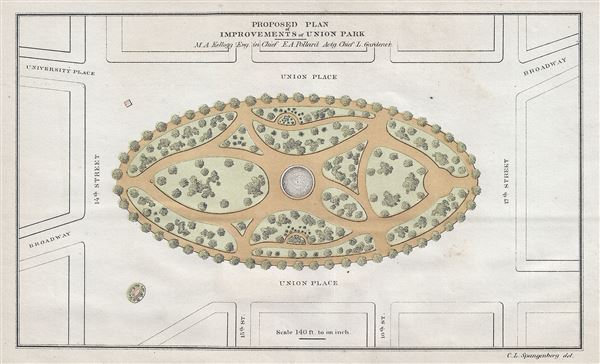This item has been sold, but you can get on the Waitlist to be notified if another example becomes available, or purchase a digital scan.
1871 Kellogg and Pollard Map of Union Square Park, New York City
ImprovementsUnionPark-kellogg-1871
Title
1871 (undated) 5.5 x 8.5 in (13.97 x 21.59 cm) 1.208333333
Description
In 1871, Parks Engineer in Chief M. A. Kellogg and Acting Chief Landscape Gardener E. A. Pollard created a new plan for Union Square. Famous landscape architects Frederick Law Olmsted and Calvert Vaux redesigned the park. They removed the fence and hedge and planted a variety of trees, widened the sidewalks and created a muster ground and reviewing stand 'to meet the public requirement of mass-meetings.' Like their most famous works, Central Park and Prospect Park, Vaux and Olmsted were meticulous in their design of the park, with every tree, pond, and bench planned. Today, because of Vaux and Olmsted's efforts, and the plan of Kellogg and Pollard, the citizens of New York City have the privilege of enjoying what is, without question, one of the finest examples of a planned urban public recreation and meeting places in New York City.
This plan was created by M. A. Kellogg and E. A. Pollard for the First Annual Report of the Board of Commissioners of the Department of Public Parks for the Year Ending May 1, 1871. Maps of Union Square Park are exceptionally scarce, making this a rare find and an important addition to any serious collection focusing on New York City.
CartographerS
Frederick Law Olmsted (April 26, 1822 - August 28, 1903) was an American journalist, landscape designer, and forefather of American landscape architecture. Born April 26, 1822 in Hartford, CT, Olmsted never attended college, instead taking work as a seaman, merchant, and journalist until 1848, when he settled at Tosomock Farm in Staten Island, New York. On June 13, 1859 Olmsted married Mary Cleveland, the widow of his brother John and adopted her three children. Olmsted’s fateful introduction to landscape design occurred in 1850, when a journalism assignment took him to England to visit public gardens. Inspired by Joseph Paxton's Birkenhead Park, he went on to write and publish Walks and Talks of an American Farmer in England. This led to additional work with the New York Daily Times (The New York Times) who sent him on an extensive tour through Texas and the American South from 1852 to 1857. It was after this trip that Olmsted wrote his popular criticism of slave economies, A Journey Through Texas. In 1858, Olmsted, along with his design partner, the architect Calvert Vaux, entered and won New York City's Central Park design competition. Though it was their first major landscape design project, the construction of Central Park from 1857 to 1866, created what many consider to be the finest planned urban recreation area in the world. They continued collaborating on such projects as Prospect Park in Brooklyn, Chicago's Riverside Park, the Buffalo park system, Milwaukee's Grand Necklace, and the Niagara Reservation. These were not just parks, but entire systems of parks and interconnecting parkways (which they invented) linking cities to green spaces. In 1883, Olmsted founded the Brookline, MA based Fairsted Company, the first landscape architecture firm in the United States. It was from this office he designed Boston's Emerald Necklace, the campus of Stanford University, the University of Chicago, the 1893 Columbian Exposition, and many other public areas. In 1895 Olmsted retired to Belmont, Massachusetts. Three years later, in 1898, he was admitted McLean Hospital, whose grounds he had designed several years before. He remained a resident and patient there until he passed away in 1903. Olmsted is buried in the Old North Cemetery, Hartford, Connecticut. More by this mapmaker...
Calvert Vaux (1824 - 1895) was a British architect and landscaper who is best remembered for his co-design, with Frederick Olmstead, of New York City's Central Park. Born in London in 1824, little is known of his early life, though it is recorded that, at 9 he was apprenticed to London architect Lewis Nockalls Cottingham, a proponent of the Gothic Revival Movement. Vaux worked for Cottingham until he was 26 years old, honing his skills and building a reputation as a skilled draftsman. During an exhibition of his watercolors in 1851, Vaux caught the attention of landscape designer Andrew Jackson Downing. Downing was looking for a partner to fulfill his revolutionary vision of urban architectural-landscaping. Dowing recruited Vaux to design buildings, bridges, and structures, while he focused on the overall landscape design. Vaux accompanied Downing to the United States where, in 1854, he gained U.S. citizenship and founded the American Institute of Architects. Vaux's partnership with Downing lasted approximately two years and resulted in a number of significant works, including the grounds of the White and Smithsonian Institute in Washington D.C. In 1852 Downing passed away in a tragic accident. At the time Downing was working on a landscape design for New York City's Central Park. In a decision that would forever change the American urban landscape, Vaux called in the fledgling landscape designer Frederick Olmstead to fill Downing shoes. Though Central Park was their first joint project, Vaux and Olmstead proved a magical combination, creating what many consider to be the finest planed urban recreation area in the world. Following the completion of Central Park, Vaux and Olmstead formed an official business partnership and went on to design Prospect Park in Brooklyn and Morningside Park in upper Manhattan. They planned one of the first suburbs in Chicago, Riverside, and were commissioned to design parks for Buffalo, NY, Milwaukee, WI, and Rockwood Park in Canada, among others. Vaux ended the partnership in 1872 and went on to collaborate with George Kent Radford and Samuel Parsons. However, in 1889 he again joined forces with Olmstead to design Downing Park, as a memorial to his mentor. Vaux tragically passed away on November 19, 1895, when he drowned in Brooklyn, NY. Learn More...

